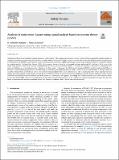Analysis of soma mine disaster using causal analysis based on systems theory (CAST)
Author(s)
Leveson, Nancy G
DownloadPublished version (2.538Mb)
Terms of use
Metadata
Show full item recordAbstract
Analyzing accidents of sociotechnical systems requires an understanding of the system safety structure. Among various methods proposed for accident analysis in complex sociotechnical systems the Systems-Theoretic Accident Model and Processes (STAMP) model is one of the most widely used model for predictive applications in the literature. The STAMP accident causality model with the accident analysis tool, called CAST (Causal Analysis based on Systems Theory) is an effective method for accident analysis. The Soma Mine Disaster (SMD), which occurred due to a fire in the underground coal mine and caused 301 fatalities in 2014, is one of the largest mine disasters in the last few decades. Although mine fires usually do not cause large number of casualties as compared to explosions in underground coal mines, the SMD has one of the highest number of deaths in the 21st century. In this paper, the CAST, which is based on STAMP is used for analyzing the SMD as it provides a system engineering perspective in accident analysis. Considering the complex nature of the SMD, a variety of factors were involved in the high number of casualties. Among them, socio-technical factors like unstructured organizational and human performance as well as inadequate safety culture, improper decision making and risk perception, which played a critical role in the SMD, are defined in an integrated system thinking framework. Finally, inadequate system control constraints are identified in each hierarchical level of the system and improvements are suggested, accordingly. It is also demonstrated that a CAST analysis is robust for the cases like the SMD, which involves high degree of uncertainty related to the occurrence of the accident. The analyses presented in this paper also show the design of prevention and mitigation measures against such disasters in different levels of the accident control hierarchy.
Date issued
2018-08Department
Massachusetts Institute of Technology. Department of Aeronautics and AstronauticsJournal
Safety science
Publisher
Elsevier BV
Citation
Düzgüna, H. Sebnem and Nancy Leveson. “Analysis of soma mine disaster using causal analysis based on systems theory (CAST).” Safety science, vol. 110, 2018, pp. 37-57 © 2018 The Author(s)
Version: Final published version
ISSN
0925-7535